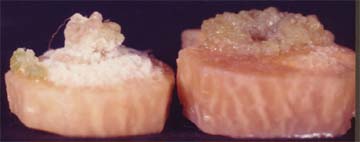 Plumeria Photo©CLCase |
Genetic Engineering of Plants(BIOL 230, Lab Experiment 16)
|
| Study the Asepsis Tutorial
before lab. |
Agrobacterium can transform plants by inserting its Ti plasmid into the plant cells. The Ti plasmid contains T (tumor-inducing) DNA which integrates into the genome of an infected plant. The T-DNA stimulates local cellular growth (the crown gall) and simultaneously causes the production of certain products used by the bacteria as a source of nutritional carbon and nitrogen.
 Crown gall on carrot slices. |
 Crown gall on tomato plant. |
 Crown gall on pecan tree. |
| Splicing genes into a variety of crops would bring new benefits to farmers and consumers. Some examples of crops. |
||
|
Squash- |
Virus resistance |
|
|
Canola- |
Cooking oil with lower saturated fat |
|
|
Cotton- |
Herbicide & insect resistance |
|
|
Potato- |
Lower-fat potato chips; insect resistance |
|
|
Soybeans- |
Herbicide resistance |
|
|
Carrots- |
Longer shelf life |
|
|
Tomato- |
Disease resistance; longer shelf life |
|

|
|
Using the Ti plasmid as a vector for genetic engineering in plants. |
|
Why is the Ti plasmid important to plant scientists? |
